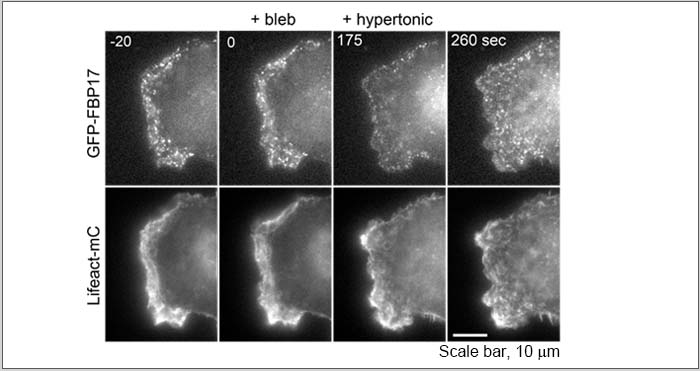TIRF Imaging of Changes in Membrane Morphology and Molecular Dynamics
Total Internal Reflection Fluorescence (TIRF) Imaging of Changes in Membrane Morphology and Molecular Dynamics under the Cell Membrane with Olympus’ Z-drift Compensation System
Introduction
One important issue in current cell biology research is to understand the mechanism of physiological phenomena associated with the intercellular communication between adjacent cells. A promising step toward this goal is live cell microscopy that enables researchers to monitor changes in cell membrane morphology and the dynamics of localized molecules at the intercellular adhesion site. Figure 1 illustrates how high-precision TIRF imaging is enabling new types of advanced cellular research. The images, captured using an Olympus motorized inverted microscope IX series, show changes in the membrane morphology and molecular dynamics under the cell membrane. The Olympus Z-drift compensator maintained a sharp focus on the cells over a long period of time enabling these images to be captured in such high quality. This process demonstrates the importance of TIRF and the Olympus Z-drift compensator to advanced live cell imaging.

Figure 1. Time-lapse images of a Cos-1 cell co-expressing GFP-17 and Lifeact-mCherry.
Examination of whether the recruitment of FBP17 to the plasma membrane is dependent on transient reduction of membrane tension caused by myosin based contraction force. FBP17 acutely disappeared from the cell edge after treatment with the myosin inhibitor blebbistatin (175 sec). This ef fect can be rescued by subsequent reduction of membrane tension induced by hypertonic buffer (260 sec), indicating that the FBP17 senses the membrane tension to assemble at the plasma membrane.
Time-lapse movie of a Cos-1 cell co-expressing GFP-17 and Lifeact-mCherry. |
Imaging System;
Image data courtesy of;
Reference;
|
Polarisation of FBP17 is induced by PM tension increase.
| |
Polarisation of FBP17 is disrupted by PM tension decrease.
| |
Polarisation of FBP17 is induced by PtdIns(4,5)P2 liberation.
| |
Polarisation of FBP17 is disrupted by PtdIns(4,5)P2 depletion.
| |
Dynamics of FBP17 at the leading edge. COS-1 cell co-expressing GFP-FBP17and Lifeact-mCherry was observed by time-lapse microscopy. The movie was taken at 1 frame per 5 seconds and played at 15 fps. | |
Acute disruption of FBP17 polarity by N-WASP inhibition. COS-1 cell co-expressing GFP-FBP17 and Lifeact-mCherry was observed by time-lapse microscopy upon addition of wiskostatin. The movie was taken at 1 frame per 10 seconds and played at 15 fps. | |
Acute disruption of FBP17 polarity by Arp2/3 complex inhibition.
|
Conclusion
Olympus’ live cell imaging solutions and Z-drift compensator facilitate long-term imaging studies of cellular processes. The Z-drift compensator utilizes low phototoxicity infrared (IR) light to detect the correct focus position, to make automatic focal adjustments, and to maintain precise focusing over time by avoiding focus drift due to factors such as temperature changes. The type of experiment described above cannot be accomplished using conventional microscopy because the images captured over time would be out of focus because of focus drift. The Z-drift compensator enables images to be captured without loss of focus. This facilitates chronological, high-precision tracking of dynamic changes of FBP17 and the Lifeact actin marker under the cell membrane.
Products Related to This Application
was successfully added to your bookmarks
Maximum Compare Limit of 5 Items
Please adjust your selection to be no more than 5 items to compare at once
Not Available in Your Country
Sorry, this page is not
available in your country.